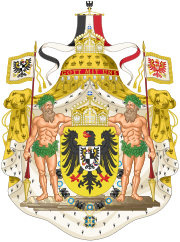Prince Henry of Prussia (1900–1904)
This article needs additional citations for verification. (July 2013) |
| Prince Henry of Prussia | |||||
|---|---|---|---|---|---|
 Prince Henry c. 1903 | |||||
| Born | 9 January 1900 Kiel, Schleswig-Holstein, German Empire | ||||
| Died | 26 February 1904 (aged 4) Kiel, Schleswig-Holstein, German Empire | ||||
| Burial | 29 February 1904 Schloss Hemmelmark, Barkelsby, Schleswig-Holstein, German Empire | ||||
| |||||
| House | Hohenzollern | ||||
| Father | Prince Henry of Prussia | ||||
| Mother | Princess Irene of Hesse and by Rhine | ||||
| Religion | Evangelical Christian | ||||
| Prussian Royalty |
| House of Hohenzollern |
|---|
 |
| Frederick III |
|
Prince Henry Victor Louis Frederick of Prussia (German: Heinrich Viktor Ludwig Friedrich; 9 January 1900 – 26 February 1904), was the haemophiliac third son and youngest child of Prince Henry of Prussia and Princess Irene of Hesse and by Rhine, and thus a grandson of Frederick III, German Emperor, on his father's side and a great-grandson of Queen Victoria through both his mother and father. He died aged four.
Life[edit]
Prince Heinrich was born on 9 January 1900, in Kiel. His father was pleased by the birth of yet another son, especially such a handsome one, as the Prince had blonde hair.[citation needed] The newborn Prince immediately received the title Prince of Prussia with the style Royal Highness, and was baptised Heinrich Viktor Ludwig Friedrich in Kiel Castle on 15 March 1900.[1] His older brothers were Prince Waldemar, a namesake of his uncle, and Prince Sigismund, a namesake of his other deceased uncle. Heinrich was named in honour of his father. The Prince was diagnosed with haemophilia as a young child, but, despite this, was a very cheerful and lively boy who liked to play a lot. As Henry grew older he became more aware of his condition.
Death[edit]
On 25 February, Princess Irene left Heinrich unsupervised for a few minutes while she went to fetch something. The playful Prince climbed a chair, and then he climbed onto the table. As he heard his mother approaching, he attempted to quickly come down but stumbled while attempting to climb down the chair and fell on the floor headfirst. He started to scream, which immediately attracted the Princess' attention. By the time she reached him, the child was almost unconscious. The doctor said the fall had not been that bad and the child would have survived had he not been a haemophiliac. However, experiencing this condition, it was certain the young Prince would die. He was experiencing a brain haemorrhage. He lingered for a couple of hours, but died the following day, on 26 February. He was four years old.
Aftermath[edit]
Prince Heinrich's premature death would later very much affect the Princess, who would withdraw into herself. One of his older brothers, Prince Waldemar, also had haemophilia. He lived up to the age of 56 and was married, without children. The middle sibling, Prince Sigismund, was unaffected by the disease.
Ancestry[edit]
| Ancestors of Prince Henry of Prussia (1900–1904) |
|---|
Notes[edit]
- ^ "Court Circular". The Times. No. 36091. London. 16 March 1900. p. 6.
Legend: X – unaffected X chromosome; x – affected X chromosome; Y – Y chromosome; ? - unknown carrier status
Source: Aronova-Tiuntseva, Yelena; Herreid, Clyde Freeman (20 September 2003). "Hemophilia: 'The Royal Disease'" (PDF). SciLinks. National Science Teachers Association. p. 7. Archived from the original (PDF) on 10 January 2018. | |||||||||||||||||||||||||||||||||||||||||||||||||||||||||||||||||||||||||||||||||||||||||||||||||||||||||||||||||||||||||||||||||||||||||||||||||||||||||||||||||||||||||||||||||||||||||||||||||||||||||||||||||||||||||||||||||||||||||||||||||||||||||||||||||||||||||||||||||||||||||||||||||||||||||||||||||||||||||||||||||||||||||||||||||||||||||||||||||||||||||||||||||||||||||||||||||||||||||||||||||||||||||||||||||||||||||||||||||||||||||||||||||||||||||||||||||||||||||||||||||||||||||||||||||||||||||||||||||||||||||||||||||||||||||||||||||||||||||||||||||||||||||||||||||||||||||||||||||||||||||||||||||||||||||||||||||||||||||||||||||||||||||||||||||||||||||||||||||||||||||||||||||||||||||||||||||||||||||||||||||||||||||||||||||||||||||||||||||||||||||||||||||||||||||||||||||||||||||||||||||||||||||||||||||||||||||||||||||||||||||||||||||||||||||||||||||||||||||||||||||||||||||||||||||||||||||||||||||||||||||||||||||||||||||||||||||||||||||||||||||||||||||||||||||||||||||||||||||||||||
